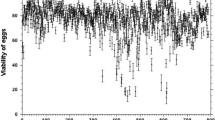Abstract
Pupal mortality is shown here to bear the main responsibility for total mortality duringDrosophila melanogaster development in crowded conditions. The dynamics of the pupa-to-adult and larva-to-adult processes of mortality follows a S-shaped logistic model, like survival in density-dependent processes. Data given here confirm to some extent Wallace's suggestion that pupal mortality is a density-dependent process.
Similar content being viewed by others
References
Ashburner, M. & Thompson, J. N., 1978. The laboratory culture of Drosophila. In: M. Ashburner, and T. R. F. Wright (Eds), The genetics and biology of Drosophila. Vol. 2a. Academic Press. New York.
Bakker, K., 1959. Feeding period, growth and pupation in larvae of Drosophila melanogaster. Ent. exp. appl. 2: 171–186.
Bakker, K., 1961. An analysis of factors which determine success in competition for food among larvae of Drosophila melanogaster. Arch. néerland. Zool. 14: 200–282.
Bakker, K. & Nelissen, F., 1963. On the relations between the duration of the larval and pupal period, weight and diurnal rythm in emergence in D. melanogaster. Ent. exp. appl. 6: 37–52.
Barker, J. S. F. & Podger, R. N., 1970. Interspecific competition between Drosophila melanogaster and Drosophila simulans: effects of larval density on viability, developmental period and adult body size. Ecology 51: 170–189.
Batschelet, E., 1971. Introduction to mathematics for life scientists. Springer, Berlin-Heidelberg-New York.
Boggild, O. & Keiding, J., 1958. Competition in house fly larvae, experiments involving a DDT-resistance and a susceptible strain. Oikos 9: 1–25.
Bonnier, G. 1926. Temperature and time of development of the two sexes in Drosophila. J. exp. Biol. 4: 186–195.
Botella, L. M., Moya, A. & Ménsua, J. L., 1983. Effects of urea on viability and mean developmental time in D. melanogaster larvae. Dros. Inf. Serv. 59: 23–24.
Botella, L. M., Moya, A., González, C. & Ménsua, J. L., 1985. Larval stop, delayed development and survival in over-crowded cultures of D. melanogaster. J. Insect Physiol. 31: 179–185.
Church, R. B. & Robertson, F. W., 1966. Biochemical analysis of genetic differences in the growth of Drosophila. Genet. Res. Camb. 7: 383–407.
De Jong, G., 1976. A model of competition for food. I. Frequency dependent viability. Am. Natur. 110: 1013–1027.
Gill, D. E., 1978. On selection at high population density. Ecology 59: 1289–1291.
Ménsua, J. L. & Moya, A., 1983. Stopped development in crowded cultures of D. melanogaster. Heredity 51: 347–352.
Moya, A. & Ménsua, J. L., 1983. Dynamics of larval competition process: the overfeeding technique in Drosophila. Dros. Inf. Serv. 59: 90–91.
Nunney, L., 1983. Sex differences in larval competition in Drosophila melanogaster: the testing of a competition model and its relevance to frequency-dependence selection. Am. Natur. 121: 67–93.
Park, T., 1938. Studies in population physiology. VIII. The effect of larval population density on the postembryonic development of the flour beetles Tribolium confusum Duval. J. exp. Zool. 79: 51–70.
Prout, T., 1980. Some relationships between density-independent selection and density-dependent population growth. In: M. K. Hecht, W. C. Steere, and B. Wallace, (Eds). Evolutionary Biology. 13. Plenum Press, New York, London.
Roughgarden, J., 1979. Theory of population genetics and evolutionary ecology: an introduction. Mcmillan, New York.
Sang, J. H., 1949. The ecological determinants of population growth in Drosophila cultures. III. Larval and pupal survival. Physiol. Zool. 22: 183–202.
Siler, W., 1979. A competing-risk model for animal mortality. Ecology 60: 750–757.
Wallace, B., 1981. Basic population genetics. Columbia University Press, New York.
Wilbur, H. M. & Collins, J. P., 1971. Ecological aspects of amphibian metamorphosis. Science 182: 1305–1314.
Wollkind, D. J. & Logan, J. A., 1978. Temperature-dependent predatorprey mite ecosystem on apple tree foliage. J. math. Biol. 6: 265–283.
Author information
Authors and Affiliations
Rights and permissions
About this article
Cite this article
Moya, A., Botella, L.M. Larva-to-adult and pupa-to-adult mortality dynamics in crowded cultures ofDrosophila melanogaster . Genetica 67, 201–207 (1985). https://doi.org/10.1007/BF02424491
Received:
Accepted:
Published:
Issue Date:
DOI: https://doi.org/10.1007/BF02424491




